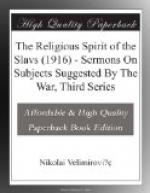in Bohemia. Christianity in Bohemia was at that
time relatively young, nearly three times younger
than in Rome. But since Prince Borivoj was baptised
by the Slav Apostle, Methodius, never did Bohemian
Christianity stand nearer to the primitive Bohemian
paganism than at the time when King Wenceslas ruled
in Bohemia, and Pope John XXIII ruled in Rome, and
Jan Huss served as preacher in a Prague chapel called
the Bethlehemian. The paganism under the style
of poor Jesus, against which fought Huss, was much
more obstinate and aggressive than the paganism under
the style of Perun, against which fought St. Methodius.
Everywhere was found a substitute for Christ, everywhere
a pretext for an easy life and for a broad way instead
of the narrow one. Sins and virtues had been
equalised by means of money. The Church buildings
had been transformed into public places for the exchange
of sins and virtues. “
Repentance, not
Money!”—exclaimed Jan Huss.
But his voice was stifled by the piercing sounds of
the drums by which the sale of absolution for sin was
announced in the streets. Again exclaimed Jan
Huss: “The whole Bohemian nation is longing
after Truth.” But the traders in Christ’s
blood and tears laughed him to scorn. The doctors
of theology asked their colleague Huss to confess
that “the Pope is the head and the Bishops the
body of the Church, and all their orders must be obeyed.”
But Huss did not care very much either about the head
or the body, but principally about the
spirit
of the Christian Church. And this spirit he saw
eclipsed. He saw men again falling back to the
creed of serving “two masters.” He
looked to the heart of the Christian religion and
saw that it was sick, and his soul revolted against
it. But his righteous revolution was regarded
as a malevolent innovation, his words as a scandalous
licence, and his tendencies as a deliberate destruction
of Christianity. Therefore Jan Huss was brought
before a tribunal of Christian judges, condemned to
death and burnt to ashes,
ad magnam Dei gloriam,
as the Bishop of Lodi preached on that occasion.
The fact was that the Council of Constance was a great
innovator, and that Huss stood for the true catholicity
of old. He fought for the primitive Christian
spirit which always inspired, vivified and purified
the Christian world, and his judges introduced a quite
anti-Christian, a quite new spirit into the Church,
the spirit of judging and killing.
The sufficient proof—if you need proof
at all—of this is that Huss suffered as
a Christian martyr and through painful suffering
brought his cause to glory; whereas his judges killed
him in the hope through a crime to promote
the Christian cause, and so covered their names with
shame. The truth and glory of Jan Huss’s
cause were manifested last year throughout the whole
of the globe. The whole world celebrated the quincentenary
of his martyr death. I participated in this celebration




